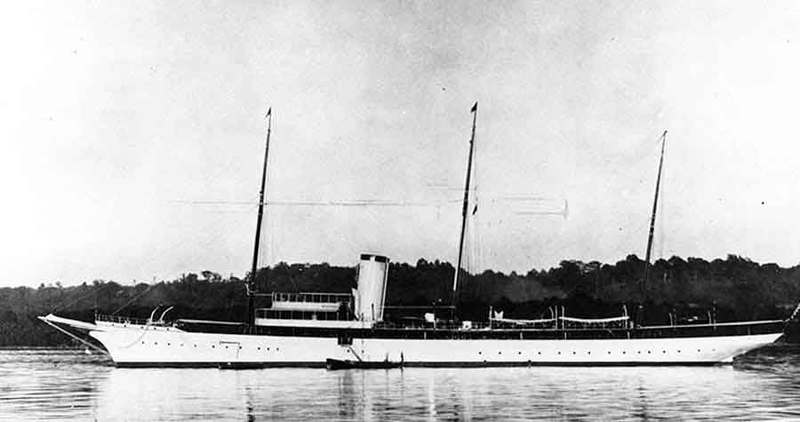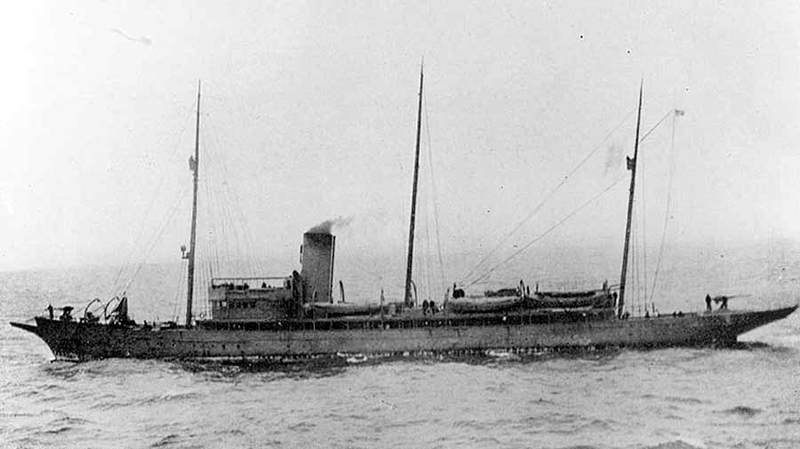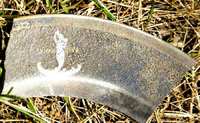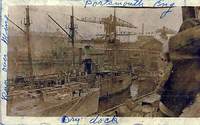Mighty Aphrodite by Donna Stuart
Mighty Aphrodite
The world's most luxurious private yacht— christened on the Kennebec— was called into service during World War I, and never returned to her former glory.
by Donna Stuart
This is a reprint of an article published in Portland Magazine in 2008. Donna Stuart, the researcher and author, and Colin Sargent, editor of Portland Magazine, have both graciously given permission to reprint the article. The text is the same and published in the magazine, but I have substituted available photos for the montages featured in the magazine.
View further information about Portland Maine in website, www.portlandmagazine.com
It was two o'clock on a cold winter afternoon, the first of December 1898, when Miss Vivie Scott smashed the bottle of champagne against the motor yacht's stem. "I christen you Aphrodite," she said, watching the ship her father was to captain slip into the frigid waters of the Kennebec River. The yacht's name caused a stir among those who were watching that day at Bath Iron Works: Why would a 59-yearold reclusive bachelor, one of the partners in Standard Oil, name his new motor yacht after the Greek goddess of love?
And why had he kept the name a secret until the launch? Was it a reflection of Colonel Oliver Hazzard Payne’s intense desire for privacy? Or was it simply the expression of his love for the open water and sailing, a love that began during his boyhood and grew during vacations in Connecticut and crew races at Yale?
It didn't matter. The secret of her name was out, and the 300-foot Aphrodite, the largest steam yacht that had ever been built in the US, was acclaimed as a "sea palace”. Designing her had been a challenge for Charles Ridgely Hanscom, BIW's Superintendent of Hulls, who had to combine a powerful steel hull — -which would make her capable of cruising the world — with the elegant lines and speed of a sailing ship. The February 1898 edition of Marine Engineering proclaimed, "The yacht is a graceful, handsome 'shippy' boat. Though a powerful vessel, she has not that heavy appearance which seems to be characteristic of many modern full-powered steam yachts."
It would be up to McKim, Mead, and White's Stanford White, one of the country's foremost — and later infamous — architects (he was portrayed by Norman Mailer in Ragtime), to design the luxurious interior appointments, including the suite of three staterooms for Payne and four for his guests.
There were no large reception rooms on Aphrodite; instead, there was an expansive deck with more than six feet between the rail and the deckhouse, providing a clear view from bow to stern, though this resulted in reduced space for the steel deckhouse and the mahogany-paneled quarters within.
There was, however, an extra large dining saloon in the forward part of the deckhouse, enabling Payne and his guests to dine amid magnificent sea views.
Aphrodite's launch was breathlessly covered in The New York Times, which continued to chronicle her travels for more than a decade — from her arrival in New York on March 29, 1899, when she "steamed up the North River and anchored off Forty-second Street" to her annual trips to Europe and the Mediterranean.
The snowy-hulled yacht became a frequent sight further up the river at West Park, where Colonel Payne had an 8oo-acre country estate with nearly a mile of riverfront.
Elizabeth Burroughs-Kelly, daughter of the estate's manager, Julian Burroughs, was just eleven when, in August 1914, she was invited for the first time to go on a cruise on the Aphrodite to Newport.
"I had my own stateroom with a bed — not a bunk — and my own bathroom with salt water ,as well as hot and cold," she later said when dictating her memoirs. "At Newport, there were other yachts in the harbor, but the Aphrodite was the largest of them all. It was the 'Queen of the Yachts,' and when we were out in the launch we could see how she towered above them all. She had graceful lines with that clipper bow on which there was a figurehead of the goddess for whom she was named.”
Julian Burroughs recalled quite a different cruise. "It had been a custom for the Colonel to take all the people on the place for a day's picnic on the Aphrodite. We would go off down the river and there were sandwiches and drinks for everyone, a privilege that, I'm sorry to say, was outrageously abused, so much that some of the Italian quarry men drank so much beer that they got sick and tracked up the fine rugs and carpets. After that there were no more outings for the workmen."
The Burroughs family did enjoy many more cruises aboard Aphrodite. During a 1916 cruise to Newport, Elizabeth's sister saw "the Colonel's own dining room, which had walls of carved teakwood. On the table were pink roses, linen, crystal, and the Aphrodite's own Minton China. Two stewards in white coats were standing ready to serve a meal. When Elizabeth asked, "What is the Colonel going to have to eat?" the steward replied, "Cream of Wheat" — modest dining for a man of such extraordinary means that he was able to give more than $8 million to Cornell University during his lifetime.
By 1917, with failing health, Payne decided to join other American millionaires who were lending their yachts to the US Navy for the war effort. Stripped of her luxurious interiors, her hull painted gunmetal gray, Aphrodite was fitted for service as a seagoing patrol boat at Brooklyn Navy Yard. While Payne had sailed her with a crew of between 55 and 60, she would now carry a crew of 128 officers and men, along with four 3-inch rapid firers, two machine guns, a Y-gun, and a large number of depth charges. No longer a wealthy man’s most prized possession, she was the USS Aphrodite, a United States man-of-war.
On June 14, 1917, USS Aphrodite sailed from New York Harbor. Payne would not live to see her return; on June 27, one day before the convoy reached France, he died, leaving an estate that The New YorkTimes estimated at $90 million. Three thousand miles away, Aphrodite and the other yachts w'ere assigned to patrol and convoy duty on the Bay of Biscay; they were the first units of the yacht squadrons that became known as the Suicide Fleet
Aprodite and her crew served gallantly, led by Captain Frederick C. Billard, later Rear Admiral and Commandant of the U.s. Coast Guard. When Billard was awarded the Navy Cross, his citation read, "for distinguished service in the line of his profession as Commanding Officer of the USS Aphrodite, engaged in the important, exacting, and hazardous duty of transporting and escorting troops and supplies through waters infested with enemy submarines and mines."
A few days after the Armistice, with Billard at the helm, Aphrodite left Brest, first for England, then for Germany. Repaired after sustaining significant damage from an enemy mine when passing by the German island fortress of Helgoland, she was the first American ship to pass through the Kiel Canal, the 61-mile-Iong canal that links the North Sea at Brunsbűttel to the Baltic Sea at Kiel-Holtenau.
In 1919, Aphrodite steamed home to her new owner, Colonel Oliver Payne's favorite nephew, Payne Whitney, who'd received the bulk of his uncle's estate. When the battle-scarred ship reached Brooklyn, she was decommissioned and her fighting equipment removed. Her buff-colored smokestack was painted with two gold chevrons — indicating her overseas service for her country — and on her bridge, a tablet was installed that contained a brief summation of her wartime activities. Sadly, she couldn't be returned to her original glory; the interior finishings so carefully removed two years earlier had been destroyed when the Long Island warehouse in which they'd been stored burned.
In 1928, following the death of Payne Whitney Aphrodite was sold to a Greek firm that used her for inter-island transport in the eastern Mediterranean. A draftsman who'd worked on her in 1899 captured the only known picture of Aphrodite after her purchase; it shows her war—won chevrons still her smokestack. It's believed that she was still in service in the 1930s, but then she disappeared, an ignominious end for the glorious Maine-built ship once hailed as "America's most beautiful yacht." Mighty Aphrodite sailed through life as a party boat, a warship, and at last sighting, a transport for hire. If you see her, tell her we love her and ask her to write home
Aphrodite Image Gallery
Marist University | Marist Archives & Special Collections | Contact Us | Acknowledgements



